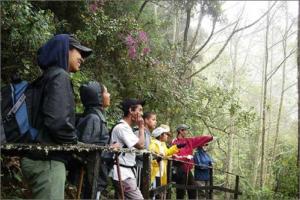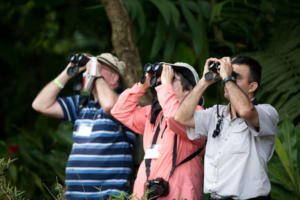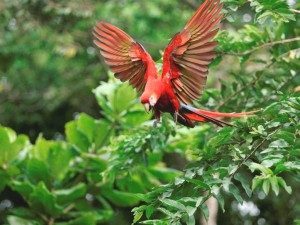Costa Rica attracts visitors from faroff corners of the world for a variety of reasons: excellent surfing, beautiful landscapes, peaceful populace, tropical climate. Not least among them is its excellent birdwatching. There are several reasons why Costa Rica is famous for the fascinating creatures that many of us so easily ignore.

The country hosts a variety of diverse ecological zones, including the Pacific and Caribbean lowlands, cloud forests, high montane páramo, dry forests of the northwest, mangrove forests, wetlands, and the middle-elevation forests of the valleys. Each ecosystem harbors a unique collection of avifauna, and there are many species endemic to the region, especially along the border with Panama. All these ecosystems can be reached within just a few hours since the country is smaller than the state of West Virginia.
Costa Rica also offers the chance for birdwatchers, who call themselves birders, to encounter many neotropical families that are rare or absent farther north, like toucans, trogons, manakins, and motmots. Migrants, like warblers, vireos, and tanagers, familiar spring sightings in the states, can be spotted living comfortably in tropical forests so far away from where they spend the breeding season. The mere chance to glimpse a resplendent quetzal, often celebrated as the most beautiful bird in the Western Hemisphere, is reason enough.
So how can one prepare for the joy and challenge of identifying birds? Birding is an easy pastime to take up, and offers the additional benefit of having a quick but endless learning curve. Beginners will soon find themselves identifying common species with ease, but it can take tremendous patience, skill, and energy to catch a glance of some elusive species, like the antthrushes that so silently stalk the forest floor. Here’s a list of tips for how to begin this richly rewarding hobby.
What You Need

Only two items are truly necessary: binoculars and a field guide. Any pair of binoculars can be used, but there is a vast market of specialized birding binoculars. As for field guides, in Costa Rica there are two good ones. The legendary Stiles and Skutch is the original, and is still widely used. Richard Garrigues’s newly released guide, which builds off its predecessor’s success, carries the advantages of being lighter weight and displaying range maps for each species. The maps are very useful, but some claim that Stiles and Skutch has more accurate coloration, and it also features more natural history and species per plate than Garrigues.
When to Go
Birds are most active in the morning and late afternoon, when the sun is least harsh. Rising early and heading out before the dawn chorus begins is usually the best time for seeing lots of birds, and on a productive day there can be frequent sightings until almost noon. Birding in the afternoon is also productive, but has the disadvantage of fading light. Paying attention to the rain is another important factor for considering when to bird, especially in the tropics. Birds get hungry, and when the rain comes down they can’t feed themselves. When showers finish or lighten, birds usually come out in force and are easily spotted.
Alone or With Friends
It’s true that more eyes see more birds, but it’s not always so simple. A single person walking quietly through the forest is the least likely to startle birds and other animals that might otherwise be long gone with a noisy group. Choosing who you bird with is important. Pairing up with other enthusiastic learners or veterans increases your chances of noticing the long-billed starthroat perched high atop a tree crown, or the motionless Baird’s trogon that so eerily blends into the leaves all around it. Being quiet and observant, whether alone or in a group, is the best rule. This also goes for asking questions of more experienced birders. Most will be eager to teach, but frequent conversation can actually be counterproductive. It’s usually best to learn by watching others.
Familiarize Yourself Beforehand
If possible, it’s a good idea to learn what bird species you might encounter in a given locale beforehand. The internet and the wealth of birding sites now available can be a great tool. There’s also a good selection of printed literature on the subject, and Costa Rica is no exception. Studying the key diagnostic features of the birds you may expect to see, especially if the area has particular specialties, will give you an edge once out in the field.
Go Where the Birds Are

This seems intuitive enough, but a common mistake among beginning birders is assuming that to see the most birds you have to venture deep in the forest or other remote wilderness locations. In fact, sometimes the opposite is true. One of the best ways to bird is to simply setup and maintain a bird feeder in your backyard. Of course, not all birds attend feeders, and some can only be seen within the forest or in other specialized locations. Especially in the forest, it can be exasperating by how few birds appear, until a mixed flock arrives and it becomes nearly impossible to identify them all before they vanish as suddenly as they came. Walking slowly and carefully attuning your senses to your surroundings is more effective than covering lots of ground. Forest edges are oftentimes productive, and taking note of where there is water or fruiting trees where the birds might congregate can make all the difference.
Study the Bird
If you spot an unfamiliar species, don’t reach for the field guide. Study the bird for as long as you can keep it in your viewfinder. What color is its plumage? Look carefully at its face and what distinctive features it might have. What shape is the bill? What color are its feet? Does it display any unusual behavior? Study the length and shape of the tail. Jotting down features in a notebook is also a good idea, since details can quickly fade from memory. After the bird is gone, then reach for the field guide. You’ll be glad you took careful notice of all the bird’s features.
Keep a List
Birders tend to love keeping lists. Life lists. Trip lists. Year lists. Backyard lists. It can become excessive, but keeping lists is one of the best ways to track your progress as a birder. It’s gratifying to see your progress from common species to coveted rarities as your skills advance. Reading through a list compiled after many outings can bring back a sudden flood of wonderful memories with friends, loved ones, and the many interesting birds you’ve come to better know.
By Frank Izaguirre

